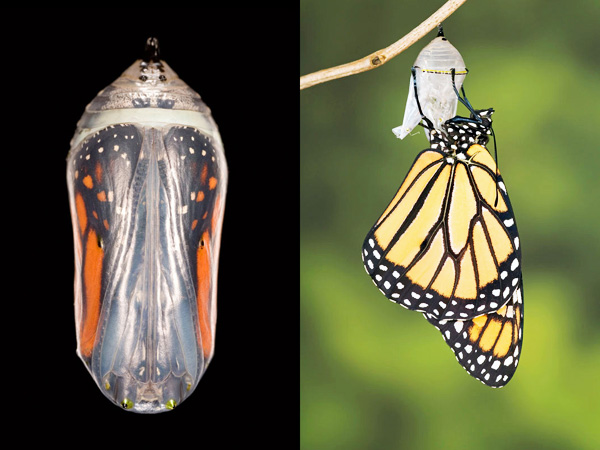Where do monarchs come from?
This is part of a blog series celebrating WWF’s Monarch Butterfly Week, May 5-9.
The monarch butterfly has a fascinating migration, not only because of the far distance it travels, but also because of it takes several generations to complete the journey. Many birds and insects migrate every year, however none of them follow this multi-generational pattern like the monarchs do.
This cycle all starts with the butterflies laying their eggs on milkweed leaves. Female monarchs will lay up to 500 eggs because only some of them (about 20 or 30) will make it to adulthood. Inside the egg is a very small caterpillar, also known as a larva. Once hatched, it goes through five stages, known as instars.
Right: Monarch butterfly (Danaus plexippus) emerging from its pupa © naturepl.com / Ingo Arndt / WWF-Canon
In the first and second instar, the caterpillar hatches from the egg and mainly feeds on milkweed leaves. Because it’s very hungry, it will eat its own eggshell and then the leaf it was laid on. Some yellow, white and black stripes may start to appear on the caterpillar. During the third and fourth instar, changes become more prominent as its stripes become more noticeable and colourful. The caterpillar is also growing in size and by the end of the fourth instar it has reached a length of one inch, and can eat a whole milkweed leaf in less than an hour!
Finally, during its last instar, the monarch caterpillar searches for the perfect place to spin a silk button attached to a leaf so that it can hang upside down. Once this happens the caterpillar has entered the pupa or chrysalis stage. The pupa is a hard green shell (which helps disguise it from predators) that protects the caterpillar during its metamorphosis. When the butterfly first emerges from the shell, it needs some time before it can begin to fly since its wings are small and weak. Did you know the butterflies pump a fluid called hemolymph into their wings to make them stronger and bigger? Once it can start flying, the beautiful monarch can fly off in search of its first nectar meal.
Learn more about these amazing species at wwf.ca/monarchbutterfly. You can support WWF’s critical monarch conservation work in Mexico by making a $50 virtual gift today! You contribution will be matched by an anonymous donor in Mexico to help make double the impact.


